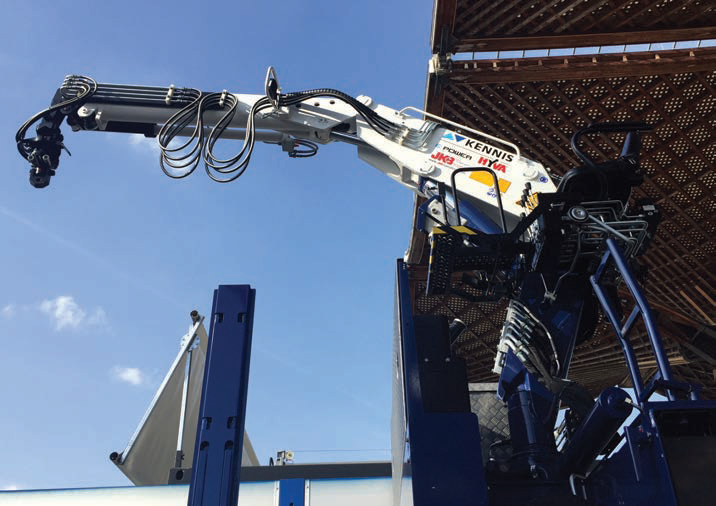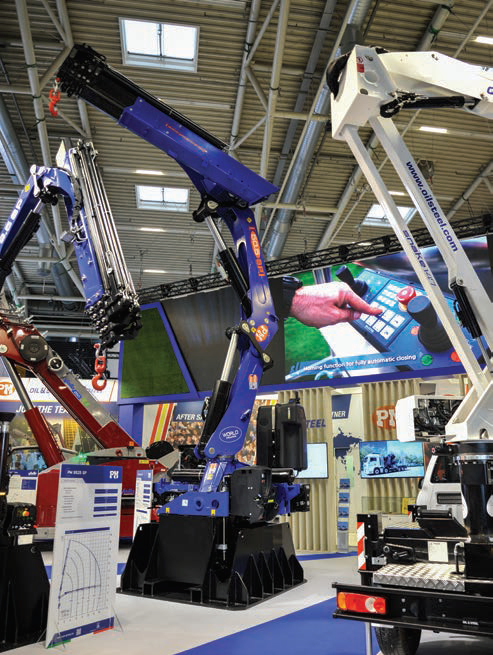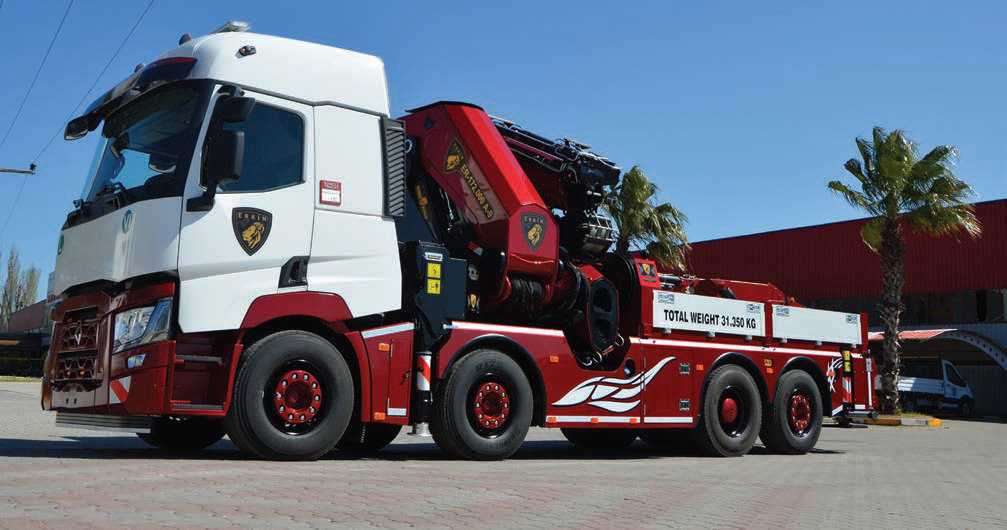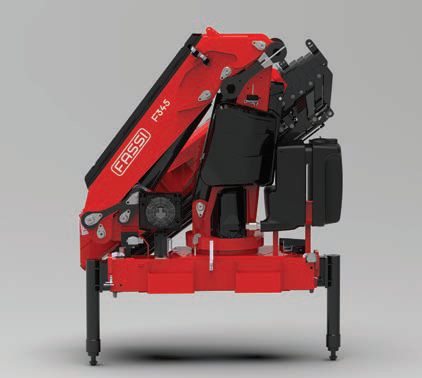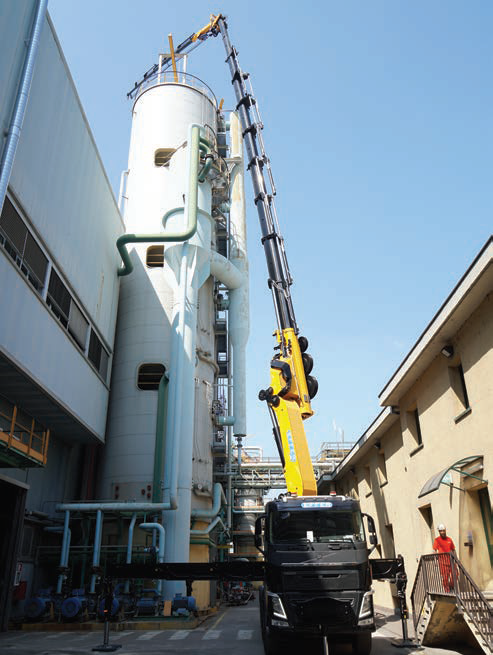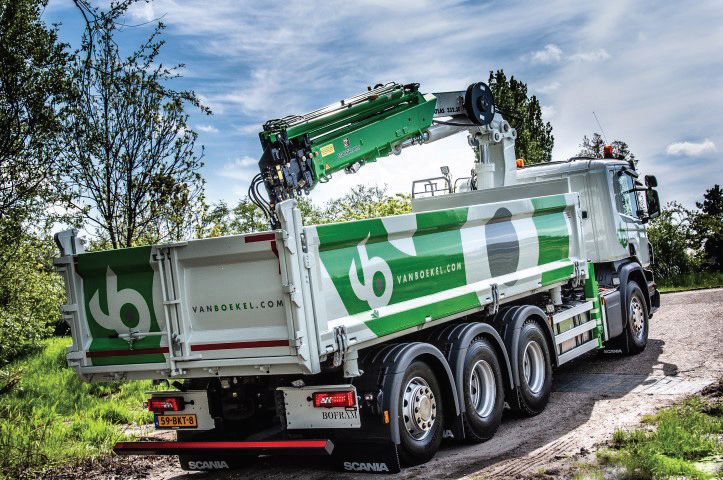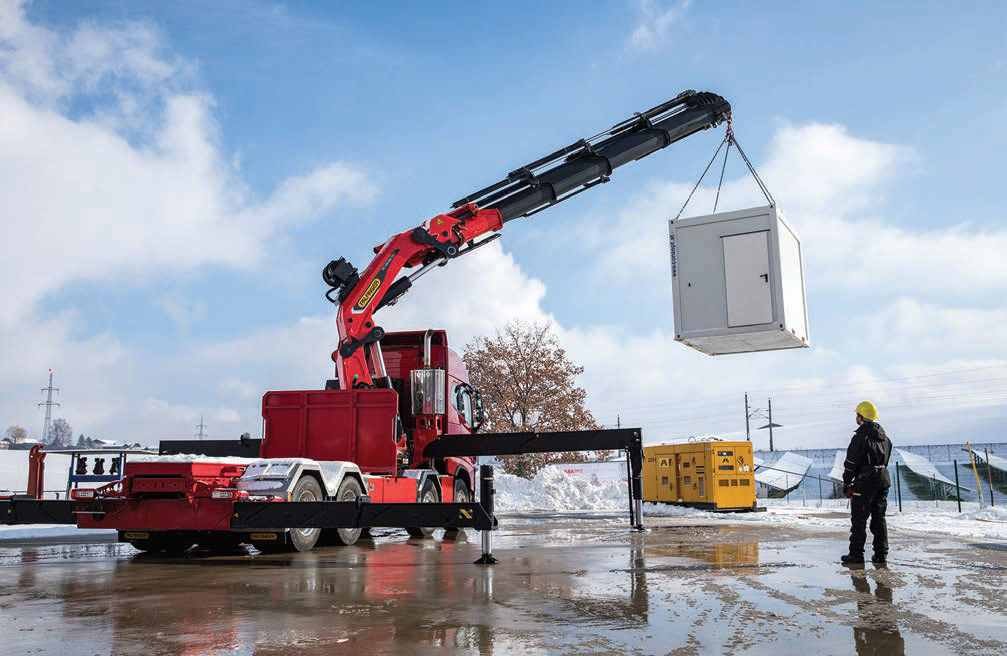Let’s get digital
20 June 2019Knuckleboom manufacturers exhibited numerous new products at Bauma. Julian Champkin found that there is increasing technical sophistication in these machines.
“There is no escape from the megatrend that is digitalisation.” That is how Palfinger described their showings at Bauma 2019. It was true for the knuckleboom cranes that Palfinger was showing as well as other manufacturers.
Palfinger itself divides its articulated knuckleboom cranes into two sections, says Michael Völker, head of product management. “SOLID covers simple designs for straightforward applications; TEC, with stateof the-art technology, is for highly challenging applications.” Palfinger showed ten new 25-37tm TEC models, and their first-ever TEC crane in the 50-60tm class.
Longer reaches and heights and capacities are some of the advantages that Palfinger claim for TEC, as are increased operator comfort and ease of control. Smart movement control is another of the digital technologies of the range: a single lever controls vertical and horizontal tip movements, made visible to the operator via a screen on his remote control belly-box.
Physically, as opposed to electronically, the TEC range has a polygonal cross-section to the boom. This makes the boom extensions especially light and rigid. As a comparison, the PK 135.002 TEC7 is some 2,000kg lighter than the similar-capacity Palfinger 150002, yet with the fly jib it gives 35% more capacity.
High-tech or low-tech, knucklebooms are booming. Manitex was reporting continued upward demand: “The replacement cycle shows no sign of slacking,” says Giovanni Tacconi, sales director. For their truck-mounted straight-mast cranes in North America Manitex report a record of more than 40% of the market share, up by 15% on the previous year.
Their PM brand of knucklebooms are made in Italy, Romania and Texas. Asia, he says, will be a prime target for growth; the new partnership with Tadano will play a large part there.
Worldwide, PM is expanding its light crane range with new models from 8tm to 11tm. A Bauma debut in the heavy range was the PM 50.5 crane destined for the European and extra-EC market.
“The world of knucklebooms is always moving” said Tacconi. “This is the biggest crane you can install on a three-axle truck. There has been a lot of demand from many UK customers. Capacities are getting bigger everywhere; the advantages of a crane installed on a commercial vehicle are increasingly being seen. For instance, there are no restrictions of the vehicle’s road speed: in many countries they can travel at up to 80km/hr, which means they can get you to a job quickly. They can operate in narrow areas, and in confined areas where vertical headroom is limited. The design of the boom, which on our models can go down to a 15° negative angle on the secondary boom, means that they can reach down into and through doorways and deposit their load inside a building.
“PM historically has made smaller cranes, in the 8-30tm range. Now we are going back to medium sized versions, and that is because the demand is there.
Tacconi added that the new Euro VI range will have a very economical fuel consumption and that the new PM 9525 SP can be mounted on a 10t truck.
Manitex too is aware of the ever-speeding march of digitalisation: “These knucklebooms have remote control, and there is an option of remote servicing. We are finding more and more customers would like support on-site in the event of any problem, and remote servicing can provide that. There is the possibility of webcam Wi-Fi on the crane, so the operator can see from two points of view at once – his own view and the view from the hook, which is displayed on a screen on his remote control box. That obviously improves safety: he can see if anyone is in the way, even if he is unloading on the other side of a roofline. It is a huge improvement of the method of using an observer to relay instructions.”
Hyva, in its 40th anniversary year, was showing new models from the mid-range of its Edge line cranes. The HC-243e is a 22.5tm crane giving 12m reach with a four-section boom. Digital innovations that the company is proud of, says line of business director Davide Catellani, are the dynamic load diagrams and the socalled ‘magic touch’, which allows automatic folding and unfolding of the boom sections to transport and working positions.
Hyva also offers the Kennis rolloader cranes; the body of their truck or trailer articulated rolloader cranes are mounted so that they can move along the flatbed, so allowing a shorter boom and getting closer to the drop point. Alternatively, it can attain a drop at further distance from the mid-point of the truck. Electric options are available: the Kennis e-Power rolloader was being shown. Its 14kW power pack can be recharged by plugin cable in five hours overnight; smart electronics allow it also to recharge from the carrier trucks drive battery while the vehicle is transiting to and from the work site.
Amco Veba was showing a variety of their small-to-medium truck-mounted cranes; different geographical regions have differing favourites among them. The 8tm class 807NT knuckleboom is in demand in Eastern Europe, where Amco Veba has been selling for over a decade. “800 of these units have been sold in Russia,” said area manager Fabio Ricco. “The reason for its popularity there, is that it is a light crane, so it does not take up payload on its truck and does not raise fuel consumption. It is very compact, so it takes up very little space as well. And it is very simple and easy to use. The demand is for a reliable light truck-crane, and the price to performance ratio must be very good. So, as an economy crane to mount on an economy truck, it is ideal for that market.” Three units have also been sold to Taiwan as vehicle-lifting trucks for the police department.
Amco Veba’s South American customers prefer the larger 19.6tm 820 model. “There is good demand for it in Argentina, Chile and Peru. Options for it include multifunctional radio remote control, winch, top seat and stand up platform.”
Ricco says in the Netherlands the 2.6tm 903 is the most demanded, which can lift 300kg at 7.4m. “Dutch streets can be narrow. Operators like to stay close to the load and see what it is doing. For that reason the radiocontrolled option is popular.”
F.lli Ferrari, also part of Hyva Group, was showcasing its new high-tech cranes, including the 60tm 9601C and 9661C. They are calling them ‘New Age’ and have 14 new models altogether. “It has been a big new investment to develop them,” says Catellani.
Their 7000 series ranges from 9tm to 18tm. The claim for these medium sized cranes is quick extension, a high-volume oil tank, protected forged double linkages, extra length stabilisers and excellent supervision of stabilising programmes. Germany, Sweden and Finland are target markets.
F.lli Ferrari's flagship, though, is the 26tm 9265C, offering endless rotation – rotation on the 7000 series is 425°. Remote control is standard with the option of remote control stabilisers as well.
Effer, part of Hiab, was showcasing its flagship new 2255 knuckleboom. The key feature here is the ability it gives users to change its configuration from eight boom extensions to ten, and to carry out this change themselves.
The technology that allows this is called KJ; the KJ system can be left installed on the crane, ready to use, completely stored inside the second boom, and with the jib mounted. Combined with the jib it allows an articulation height of 35m. The 2255 can also be equipped with a second jib, which raises the articulation height still further, to 49m. The second jib has CE certification, and can be operated via remote control, which means that all movements of the crane can be made simultaneous. In its maximum configuration, of eight sections plus two KJ units plus fly jib, the 2255 can reach a height of 55m.
A connectivity system on this and other Effer knucklebooms is the Remote Assistance Control Effer (RACE) and is another function of the electronic management system Progress 2.0. It offers remote support; the user can monitor the performance of the crane from any stationary or mobile device, smartphone or tablet. Data is stored and can be consulted; using the portal there is no need to download software or an app. Real-time tracking shows the location of the crane on its journeys to and from site; hours of work, with the percentage of working time with the various attachments, can be monitored.
Atlas, which celebrated its hundredth anniversary this year, showcased the 262.3. With a capacity of 26mt, is available with up to four extension sections to the boom. “That is one of our larger models, more for the US market than for Britain,” says UK sales manager Dave Keld. “They tend to have more space for deliveries in the US, and UK customers need something less massive, for tighter sites.”
“We focus on builders merchants, brick and block deliveries, garden landscaping and the like, and primarily on the middle range of that market.”
Again, technology can offer advantages to those that want them: “We do three different stability packages. Simplest is the staged package, which gives load charts for 50% extension and for 100% extension of the leg positions. A fully proportional package uses proximity sensors on the legs to calculate the stability of the crane for every position of the legs, in 1mm increments.
Keld highlights the Ahmeko system, where the load on the vehicle is also taken into account in the calculations. Sensors measure the vehicle’s position relative to the ground – whether the bed of the truck is horizontal or angled – and warns if, for example, one wheel is about to lift.
“A truck-mounted crane will obviously be more stable when it is carrying a cargo, which acts as a counterweight, but the cargo of course reduces in weight as the crane unloads it. Systems that do not consider cargo weight have to assume the worst possible scenario, that the truck is unloaded, when they calculate the load chart; which means that they cannot take advantage of the greater hook distances that are allowable when the truck is partially unloaded. The Ahmeko system gives you the full allowable hook distance for every loading of the truck; so an operator could unload, say, his first pallet of bricks to the greatest distance, and subsequent loads progressively nearer to the truck.”
The fully proportional option, he says, is the most popular with UK buyers: “As a mid-range system that is still economical it accounts for 60 to 70% of what we sell.”
Not all their cranes are truckmounted: “We sell them on flat-bed trailers as well, powered by Hatt donkey-engines. We have several on stand-by in our workshop, which cuts delivery times down to 2-3 weeks, as opposed to 8-10 weeks for a truck mount.”
Business at their UK base and workshops in Bradford is booming. “We are busier than we were this time last year” he says. “In fact we are looking at expanding our premises.”
Fassi classify their knucklebooms as light, medium and heavy duty. The ‘heavy’ part of the range starts at 41tm but the model they are particularly pleased with now is their latest offering, the F345, at the mid-upper end of the medium duty range. “The cross-section of the boom is a new design” says marketing manager Silvio Chiapusso. “It is now hexagonal rather than rectangular. This gives it extra strength, so it delivers greater lifting performance—capacity and extension—with less thickness of plate. The sliding plate on the mounting is also lighter and more compact. The crane is lighter, but better: performance is up, weight is down.”
The crane has two articulations and can be supplied with up to eight telescopic boom sections. Its capacity is 33.2tm and maximum hydraulic reach is 20.5m. On the version shown at Bauma, a configuration with six telescopic booms combined with the L214 hydraulic extension, the reach can be increased to 26.7m. The crane is being offered in various versions; there can be up to eight hydraulic booms in the standard configuration.
The crane is available with continuous rotation on a slew ring, the 345RB. It is intended for fitting onto three-axle vehicles.
All models feature a version with short secondary jib and with remote control (which for Fassi knucklebooms is fitted as standard equipment on cranes with lifting capacity of 28.35tm and above.) They come equipped with Fassi’s FX500 control system, the D850 hydraulic distributor bank, RCH/ RCS radio controls and FSC-S or H stability controls. “Fassi are planning to expand the range, to go to 150tm,” says Chiapusso.
The Turkish company Erkin World Power, a family firm founded in 1982 and now in its second generation, had, it says, the largest knuckleboom on show at Bauma. Its ER450.000, with a capacity of 150t, is claimed as the most powerful knuckleboom in the world. The ER-172.000 is smaller, but still qualifies as enormous. It lifts 45t and has a 22m reach.
Erkin’s Gürhan Türkoglu is an advocate for knucklebooms large and small. “The fact that the hook is directly attached to the boom gives so many advantages,” he says. “It means that there is no sway, as there would be if the hook was suspended from a rope. That makes positioning the load much easier, and much more precise. If you are trying, say to manoevre an item of furniture through an upperstorey window, a knuckleboom is exactly the crane that you need.”
“They can operate also in low headrooms—moving machinery under a roof or inside factories— and in narrow spaces, with high manoeuvrability.”
The standard use for a normalsize knuckleboom is to carry a cargo to, say a building site on the flat-bed of the truck, and use the knuckleboom, mounted either at front or read to unload it. The trucks of these EWP machine are massive, up to six axles, but so are the knucklebooms, and when stowed for travel they take up the whole length of the truck leaving no space for cargo. Not a problem according to Türkoglu: “In some countries the truck can tow a trailer carrying the load; so if you have, say, concrete façade components for a building you can bring them to the site and install them with a single mobile unit.”
The ER-172.000 A-9, on a four-axle truck, has a total weight of 31t and a capacity of 34t. Colour display remote control is an option, as is a soft ramp cut-off system: when the load exceeds the capacity limit or the settings of the sensors that determine the working limit of the crane, stop movements are carried out with a smooth ramp to prevent load oscillations and to protect the crane. An Improved Stability Control system displays the percentage of the load taken by the support legs and the weight on the stabiliser. Working capacity is determined automatically according to the position of the stabiliser and the crane.
